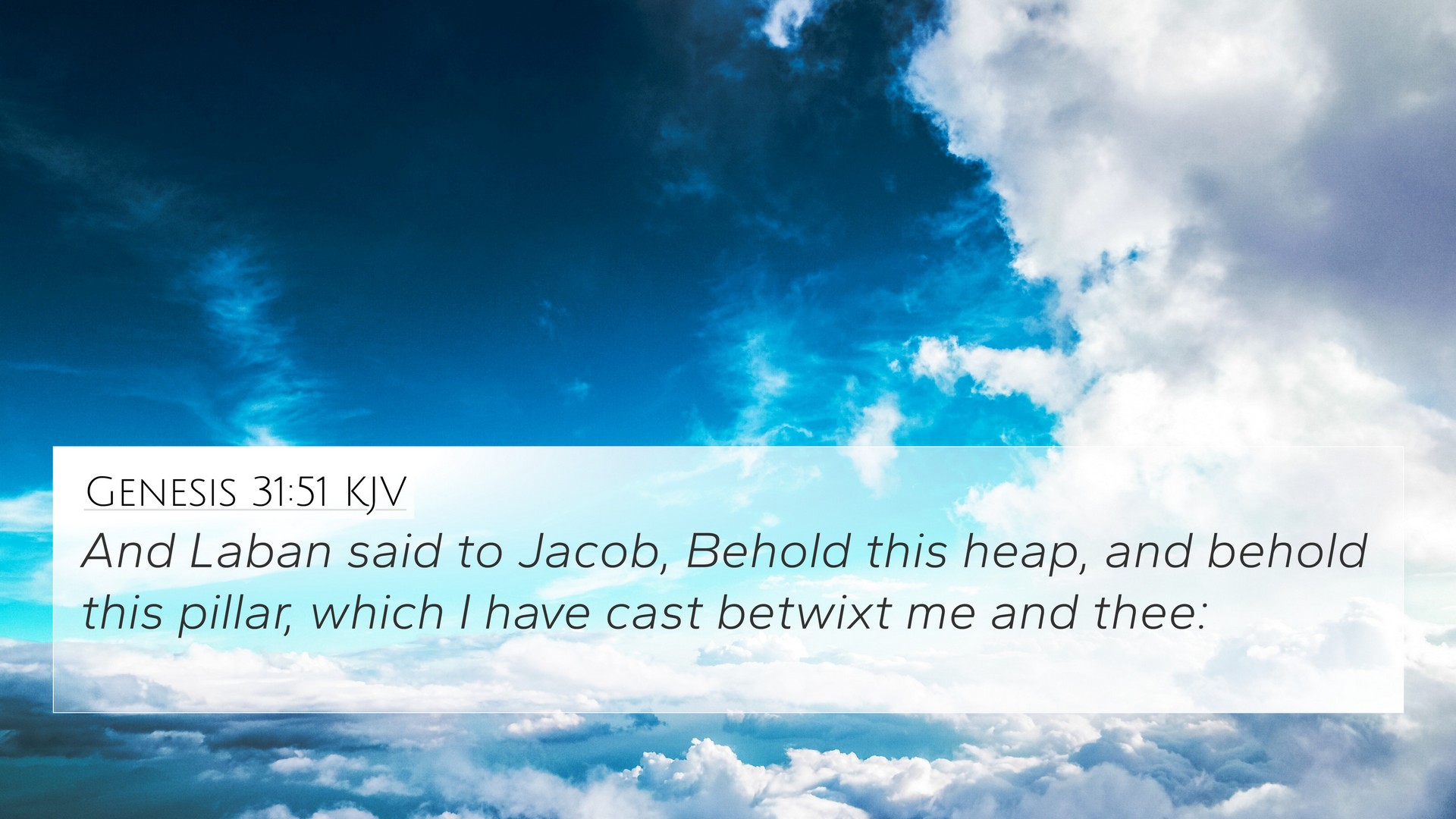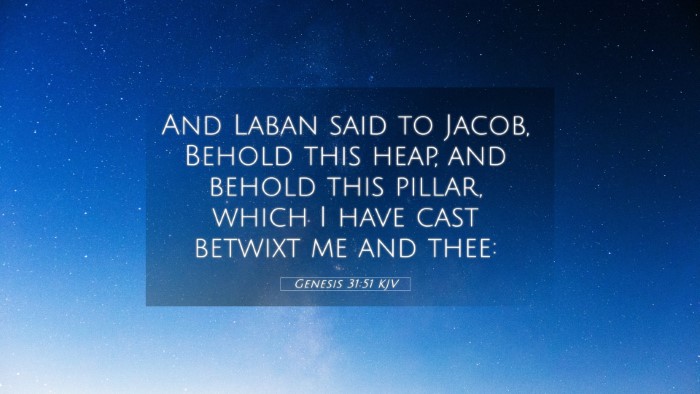Understanding Genesis 31:51
Genesis 31:51 states: "And Laban said to Jacob, Behold this heap, and behold this pillar, which I have cast betwixt me and thee;" This verse occurs in a larger narrative where Jacob and Laban are making a covenant, establishing boundaries, and emphasizing their peaceful separation. This passage is rich in significance, reflecting themes of promise, integrity, and the importance of establishing agreements between individuals.
Commentary Insights
- Matthew Henry's Commentary:
Henry notes that the heap signifies a witness to their covenant. It is a reminder of their solemn agreement and the trust they place in God as they part ways. The heap serves as a physical symbol of their commitment to honor the terms of their understanding.
- Albert Barnes' Notes:
Barnes emphasizes that this moment encapsulates the tension and eventual reconciliation between Jacob and Laban. He highlights how the pillar erected serves both as a boundary and an acknowledgment of their respective territories, encapsulating divine oversight in their dealings.
- Adam Clarke's Commentary:
Clarke elaborates on the cultural significance of such markers during biblical times, noting that they function as legal testimonies. The action of casting the heap and pillar symbolizes a formal agreement, protecting both parties' interests and maintaining peace.
Thematic Connections
This verse invites exploration of several broader biblical themes:
- 1. The Importance of Covenants: The idea of agreements, or covenants, runs throughout Scripture. This moment reflects a microcosm of God's covenantal nature with humanity.
- 2. Boundary Setting: The establishment of boundaries is critical in relationships, often revisited in texts about property and relationships (e.g., Proverbs 22:28).
- 3. Trust and Integrity: The necessity of trust in relationships is highlighted in this encounter, similar to the reliance on God's promises (e.g., Hebrews 11:1).
Related Bible Verses
This verse can be cross-referenced with several other key passages, drawing connections within the biblical narrative:
- Genesis 9:9-17 - God's covenant with Noah, highlighting the significance of covenants.
- Genesis 15:18 - The covenant between God and Abraham as a foundational moment in biblical history.
- Exodus 19:5 - God's call for Israel to be a treasured possession, also a covenantal reference.
- Jeremiah 31:31-34 - A prophecy of a new covenant, emphasizing the continuity of divine agreement.
- Matthew 5:37 - Jesus' teaching on the importance of honesty and integrity in promises.
- Philippians 2:14-15 - The call to unity among believers, paralleling the resolution found in Laban and Jacob's interaction.
- Hebrews 9:16-17 - Discussing the need for a will or covenant to have force; relevant to understanding the implications of a covenant.
Cross-Referencing Biblical Texts
When studying Bible verses, cross-referencing can provide deeper insight into the themes and messages. Here are some tools and guidelines for effective cross-referencing:
- Tools for Bible Cross-Referencing:
- Bible concordance to find verses related by themes or keywords.
- Cross-reference Bible study guides that outline associations among different scriptures.
- Bible reference resources such as interlinear Bibles that showcase original language connections.
- Methods to Utilize:
- Identifying connections between the Old and New Testaments.
- Comparative studies of themes between the Gospels and letters of Paul.
- Using Bible chain references to acknowledge repeated themes or directives throughout Scripture.
Conclusion
Genesis 31:51 encapsulates the importance of covenants, the establishment of boundaries, and a call for integrity in relationships. The insights from public domain commentaries enhance our understanding of this crucial moment between Jacob and Laban. By engaging with biblical cross-references, we can develop a richer understanding of God's overarching narrative and the interconnectedness of Scripture.


